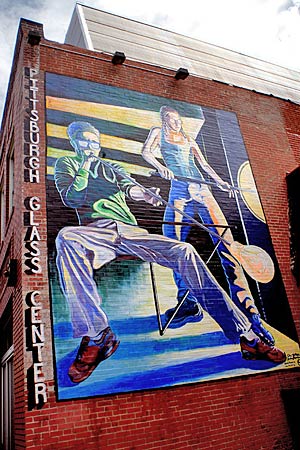Thinking and knowledge in short supply world-wide
 The Pittsburgh Glass Center is located in the Penn Avenue Arts District. Photo from Popcity. (I accidentally trashed that day's photos, including photos of the four working studios and the art gallery...)
The Pittsburgh Glass Center is located in the Penn Avenue Arts District. Photo from Popcity. (I accidentally trashed that day's photos, including photos of the four working studios and the art gallery...)Frequently I make the point that "the problem" isn't "blight" or "dilapidation" but lack of investment--disinvestment. Calling a property "blighted" is a form of what I call "blaming the building." When applied to historic buildings, the solution that derives from "blaming the building" style thinking is, too often, demolition.
But the solution to disinvestment is investment, not demolition. (And demolition merely creates another form of "blight," a hole, a vacuum that requires money to be filled...)
The Conservatives in the UK propose an "x-list" to identify buildings that are candidates for demolition. Even though they add a proviso:
Simply being ugly won't be enough to condemn a building to the wrecking ball. Candidates for destruction will also have to be uninhabited or unused, have 'a distressing and anti-social impact' and blight the local economy[;]
according to "Hate a building? Ask the Tories to knock it down," from The Observer.
Funny, this is a skirmish I'm dealing with now over the Uline Arena. Neighbors aren't thinking about rehabilitation and adaptive-reuse, which are the most successful and sustainable urban revitalization strategies, but demolition. And it turns out that the Uline is a place that marks important stories in the Civil Rights movement in terms of providing integrated public places. In this case it was in 1948, five years before public "accommodations" (restaurants, hotels, theaters, arenas...) were desegregated in DC as a result of the John Thompson restaurant case.
 Click here for the article Before Montgomery and Greensboro: The Desegregation Movement in the District of Columbia, 1950-1953.
Click here for the article Before Montgomery and Greensboro: The Desegregation Movement in the District of Columbia, 1950-1953. I was on a tour of the Penn Avenue Arts Initiative last week with someone else from DC, and his reaction after the tour was "why can't the community development corporations in DC accomplish anything?"--when you see how much they can accomplish in Pittsburgh, with a much weaker economy (although a much stronger set of foundations, leaders with vision, starting with Arthur Ziegler and the Pittsburgh History and Landmarks Foundation, which was founded in 1964, and a focus on and a demand for accountability and results), there seems to be little excuse for the failures of CDCs in DC ... although there are reasons for it, which are not politically correct to say.
(This link from the Popcity online magazine for Pittsburgh lists a variety of articles on the Penn Avenue project. Note that Popcity is produced by the same people who do the Model D online magazine for Detroit.
I also met Mtamanika Youngblood, founder of the Historic District Development Corporation in Atlanta, which is featured in the video "Block by Block" by the Architecture Foundation, and I told her about how much her work has influenced me, as the organization takes on projects only when they meet all three of their organizational objectives:
1. Historic preservation;
2. Economic development;
3. No displacement.
She said it always comes down to respect, for people and place. (And she's agreeable to doing a presentation in DC!)
In DC I think we suffer from a paucity of respect for both.
And this is a problem generally. And especially with community development corporations. Ironically, I had a side conversation with Kennedy Smith a couple weeks ago, about the "tension" in the Main Street world over community development corporations vs. independent organizations for commercial district revitalization (you can also include Business Improvement Districts in this discussion).
We both agreed that the structure doesn't matter. That what matters is the vision and commitment to (1) asset-based revitalization and (2) deliberative civic engagement.
BIDs are great funding mechanisms. We just need them to have the right vision and approach. And that's where Main Street comes in...
Index Keywords: urban-revitalization; historic-preservation



0 Comments:
Post a Comment
<< Home